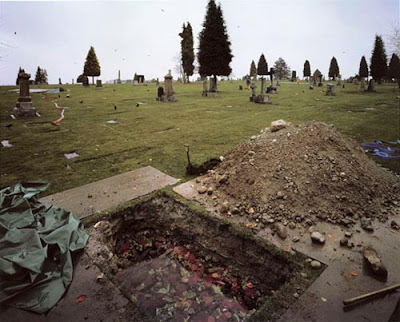Eena dee schienent Bilda aufnemmt
 |
| Jeff Wall by Hermann Wendler, 2007 |
IIn tracing and detailing the extent of the Russian Mennonite diaspora,
one spends a lot of time on the look-out for key names – such as Toews, Unrau,
Wiens, etc. Many names, however, exist
well beyond the diaspora – Becker, Unger, Wall, etc.
Regarding the surname Wall, I have always been intrigued by the artist
Jeff David Wall of Vancouver, British Columbia – is he of the Dutch Wall’s, the
Norwegian Wahl’s, the Irish Wall’s (who are actually Dutch) or the Mennonite
Wall’s – if he is Mennonite, is he of the Belgian Vanderwalle’s or de Walles, or of the Frisien Walde /
Waldens? Nor is Wall’s photo of any
assistance. I, for example, look just
like my father, grandfather, great-grandfather – all the way back to C.M. Wall,
the earliest for whom an image exists.
Wall does not look unlike a Dutch-Flemish Wall, but they have also,
possibly due to shared heritage, also looked suspiciously Irish.
So leaving off the Jerry Springer – Montel Williams investigatory work ,
Arthur Lubow, of the New York Times, actually published the answer to the
dilemma in his bio-piece on Jeff Wall , 25 February, 2007. In a piece title “The Luminist,” Lubow reveals that Jeff Wall, that great Canadian
photographic artist is actually – “Jewish”.
“Jewish?” one asks. “Jewish” he
says.
Interesting, but the plot thickens even further – Jeff Wall is Jewish –
all four of his grandparents were Jews from Odessa. So Wall is Jewish, but his also Russländer
Jewish from Odessa – the commercial center for the more rural Ukrainian
Mennonite colonies of Chortitza and Molotschna.
“One of three children born to a physician father and a homemaker mother, Wall, who is 60, grew up in a comfortable neighborhood in south Vancouver, where his parents encouraged his early ambition to be an artist. Although all four of his grandparents were Jewish immigrants from the Ukrainian city of Odessa, and he has produced two photographs set in a Jewish cemetery, he says that his parents “weren’t religious, weren’t very observant of anything,” and that Judaism “is not a subject that I’m that obsessed or fascinated by.”” (Lubow, NYT).
Until this point, I was not aware that Wall was a Jewish surname – it is
a given name, not patronymic, so its existence in either a Germanic or the
Jewish culture presents a sort of dilemma.
But its appearance in Odessa widens the mystery (which truthfully could
be quite easily cleared up by contacting the Wall, I suppose – but I will rest
secure in the Russländer – Odessa – BC connections – what more can one really
ask?).
Interestingly, cruising several Jewish genealogical sites (the
equivalent of our Gramma), one finds that the Jewish surname Wall seems to only
occur relating to Odessa and a subsequent migration to Argentina. Interesting.
Regardless, our Russländer Jewish cousin has made quite a name for
himself in the world art scene – his photography is collected in almost every
major contemporary art collection in the world including the Museum of
Contemporary Art in Chicago, the Art Institute of Chicago, MOMA in New York,
various museums in Germany, and even the sacrosanct Centre Pompideau in
Paris. His is big stuff – and so is his
art – often measuring over 10 square feet – as many as 84 square feet – his back-lit
prints are huge.
“I don’t like the traditional 8 by 10 … They were done that size as displays for prints to run in books. It’s too shrunken, too compressed. When you’re making things to go on a wall, as I do, that seems too small.” The art that he liked best, from the full-length portraits of Velázquez and Manet to the drip paintings of Jackson Pollock and the floor pieces of Carl Andre, engaged the viewer on a lifelike human scale. They could be walked up to (or, in Andre’s case, onto) and moved away from. They held their own, on a wall or in a room. “If painting can be that scale and be effective, then a photograph ought to be effective at that size, too,” (Lubow, ibid).
Wall recently made news when his studio piece Dead Troops Talk (1992) fetched a record US$3.67 million at
Christies – New York.
Dead Troops Talk could be
interpreted as a peace-motive. Wall
subtitled the work, A vision after an
ambush of a Red Army patrol, near Moqor, Afghanistan, winter 1986. It shows a number of Soviet troops waking up
after the battle and beginning to converse – seemingly an attempt to come to
grips with their massacre by the USA-backed Mujahedeen
rebels. Afghanistan was invaded by NATO
troops after the 9-11 Attacks of 2001 – that the American and Canadian troops
were now fighting the same Mujahedeen
rebels they had once backed against the invading Soviet forces, only adds
subsequent depth and expression to the work.
 |
| Dead Troops Talk, 1992 |
Of course, my favorite Wall pieces are still The Flooded Grave (1999-2000), an image of a flooded Jewish cemetery
on display at the Art Institute of Chicago, and Morning Cleaning, 1999, held by the Walker Art Center in
Minneapolis, Minnesota. Morning Cleaning
shows the cleaning of the Mies van der Rohe pavilion at the Barcelona World’s
Fair – one of the world’s greatest photographers photographing the work of one
of the 20th Centuries greatest architects in the mundane state of
being cleaned. Such is the eye and
genius of Wall – a Russländer for the 21st Century, if our closest
connection is merely Odessa and not Molotschna.
 |
| Flooded Grave, 1999-2000 |
 |
| Morning Cleaning, 1999 |
- Lubow, Arthur, “The Luminist,” The New York Times, New York, New York, USA, 25 Feb, 2007, http://www.nytimes.com/2007/02/25/magazine/25Wall.t.html?pagewanted=all , downloaded 09 May, 2012, 03:00 am.

No comments:
Post a Comment